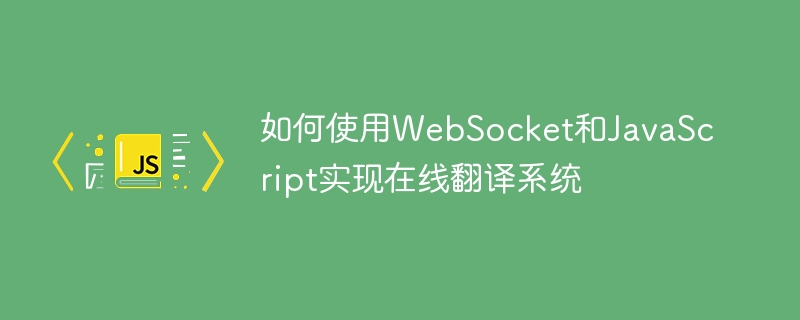Home >Web Front-end >JS Tutorial >How to implement an online translation system using WebSocket and JavaScript
How to implement an online translation system using WebSocket and JavaScript
- WBOYWBOYWBOYWBOYWBOYWBOYWBOYWBOYWBOYWBOYWBOYWBOYWBOriginal
- 2023-12-18 15:39:431536browse

How to use WebSocket and JavaScript to implement an online translation system
Introduction:
With the development of the Internet, translation services have attracted more and more attention and demand. Using WebSocket and JavaScript to implement an online translation system allows users to obtain translation results in real time and improve translation efficiency. This article will introduce how to use WebSocket and JavaScript to achieve this function, and provide specific code examples.
- Prerequisites
Before starting the implementation, make sure you already have a server running WebSocket. You can use any popular backend technology to implement a WebSocket server, such as Node.js, Java, Python, etc. This article will use Node.js as an example to explain. - Implementation steps
Step 1: Create a WebSocket connection on the client
First, create a WebSocket object in your HTML file and connect to the server. This is achieved by using the WebSocket constructor.
const socket = new WebSocket('ws://localhost:8080');In the above code, we set the connection address to ws://localhost:8080. You can modify the address according to the actual situation.
Step 2: Send translation request
By listening to the input event of the text box, send the content to the WebSocket server after the user inputs the content.
const inputElement = document.getElementById('input');
inputElement.addEventListener('input', () => {
const message = {
type: 'translate',
content: inputElement.value
};
socket.send(JSON.stringify(message));
});In the above code, we encapsulate the user's input into a message object and send it to the server.
Step 3: Receive translation results
Use the onmessage event of WebSocket to listen to the message sent by the server, and process it accordingly according to the message type.
socket.onmessage = (event) => {
const message = JSON.parse(event.data);
if (message.type === 'translation') {
const translationElement = document.getElementById('translation');
translationElement.innerHTML = message.content;
}
};In the above code, we first parse the message sent by the server into a JSON object. If the message type is translation, the translation results are displayed in the specified element.
Step 4: Implement server-side logic
On the server side, we need to listen for WebSocket connection requests and process translation requests.
const WebSocket = require('ws');
const wss = new WebSocket.Server({ port: 8080 });
wss.on('connection', (ws) => {
ws.on('message', (message) => {
const request = JSON.parse(message);
if (request.type === 'translate') {
// 在这里实现翻译逻辑
const translation = translate(request.content);
const response = {
type: 'translation',
content: translation
}
ws.send(JSON.stringify(response));
}
});
});In the above code, we first create a WebSocket server and listen to port 8080. Then, we listen to the client WebSocket connection request in the server's connection event, and process the translation request in the message event. According to the content requested by the client, the translation function is called on the server side for translation, and the translation result is encapsulated into a response object, and finally sent back to the client.
- Summary
This article introduces the steps of how to use WebSocket and JavaScript to implement an online translation system, and provides specific code examples. By using WebSocket to achieve real-time two-way communication, we can obtain translation results in real time after the user inputs content, improving translation efficiency. I hope this article will help you implement an online translation system!
The above is the detailed content of How to implement an online translation system using WebSocket and JavaScript. For more information, please follow other related articles on the PHP Chinese website!
Related articles
See more- Long connections and timeout issues in WebSocket (code)
- Detailed code explanation: Using Go to build a live video barrage system based on WebSocket
- How to determine whether a value is undefined in javascript
- Why does javascript encoding produce garbled characters?
- How to use WebSocket to achieve real-time communication in Vue

